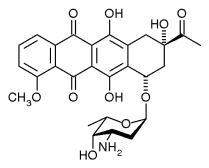Definition
Daunorubicin is an anti-cancer drug that kills cancer cells. The brand names are DaunoXome for the liposomal formulation and Cerubidine for the daunorubicin hydrochloride formulation.
Purpose
Daunorubicin is available in two different formulations, the daunorubicin hydrochloride and daunorubicin citrate liposome. The liposomal daunorubicin formulation places the drug in lipid molecules. This formulation is able to penetrate cancer cells more effectively because of its smaller size, and it remains in the body longer when compared to the daunorubicin hydrochloride formulation. The daunorubicin hydrochloride is approved by the Food and Drug Administration (FDA) to treat acute myelocytic leukemia (AML) and acute lymphocytic leukemia (ALL). It is also sometimes used to treat chronic myelogenous leukemia (CML), non-Hodgkin's lymphoma, and psoriasis. The liposomal formulation of daunorubicin is used to treat advanced HIV-associated Kaposi's sarcoma.
Description
Daunorubicin interferes with the cells' production of DNA and RNA by inserting itself between the molecules that make up DNA and RNA. It also works by inhibiting the enzyme responsible for repairing of DNA (topoisomerase II enzyme). The structure of daunorubicin is very similar to that of doxorubicin, and both drugs function in the same way.
Recommended dosage
In the treatment of acute myelocytic leukemia (AML), the dose is 30 to 60 mg of daunorubicin per square meter of body surface area given for three to five days, and the dose is repeated every three to four weeks.
In acute lymphocytic leukemia (ALL), 25 to 45 mg per square meter of body surface area of daunorubicin may be given on day one every week for four cycles, or alternatively may be given at a dose of 30 to 45 mg per square meter of body surface area for three days. The dose for patients receiving daunorubicin citrate liposome is 20 to 40 mg per square meter of body surface area every two weeks, or 100 mg per square meter of body surface area every three weeks.
Patients with decreased liver or kidney function may receive lower doses of the medication than other patients. This medication is usually administered directly into the vein (intravenous, or IV) over the course of three to five minutes. It may also be diluted in a solution to be given over fifteen minutes to one hour.
Precautions
A major problem with the use of daunorubicin is that it may cause a serious heart problem known as heart failure. Some authorities suggest that giving any individual patient more than 900 to 1000 mg of daunorubicin per square meter over the course of their entire life may increase risk of heart injury. Other authorities recommend that the total lifetime cumulative dose not exceed 550 milligrams per square meter. The patient's baseline heart function is obtained prior to starting therapy and is monitored every few cycles of chemotherapy. If the heart function is significantly decreased from baseline, the drug is discontinued.
Side effects
There is a risk that heart rhythm problems will occur during daunorubicin therapy. Later, patients may develop heart failure. However, patients receiving daunorubicin are, in fact, less likely to develop such problems than are patients receiving doxorubicin.
In addition, the activity of the bone marrow in producing white blood cells to fight infections, platelets to control bleeding, and red blood cells for oxygenation may be impaired by the drug. This and the development of heart problems are the major side effects that may cause doctors to lower the dose of daunorubicin.
Other side effects associated with daunorubicin therapy are nausea, vomiting, ulcerations of the mouth, diarrhea, and hair loss. In addition, the medication has a harmless side effect about which patients should be forewarned; urine and tears may take on a red color.
Patients receiving daunorubicin in conjunction with certain other anticancer drugs may (very rarely) develop a certain type of leukemia. The drug is also an irritant to the skin and tissues of the body. Patients who notice burning or pain with infusion of the drug should notify the nurse immediately to assess if the drug has leaked from the vein into the surrounding tissue. If this occurs, the drug infusion is stopped immediately and appropriate actions are taken to minimize side effects due to tissue damage.
KEY TERMS
- DNA
- A molecule found in all living cells that contains tiny bits of genetic information
- RNA
- A molecule that interacts with the genetic information contained in cells.



